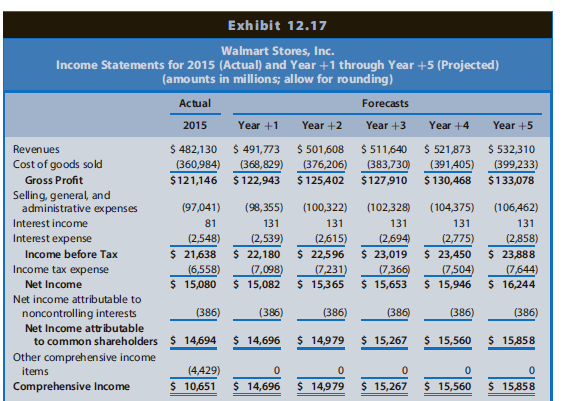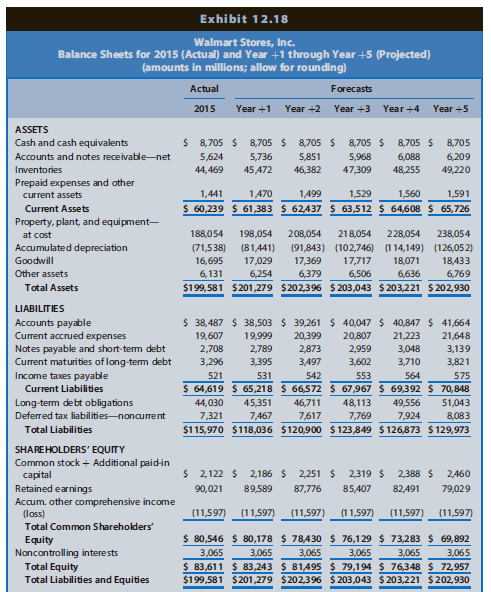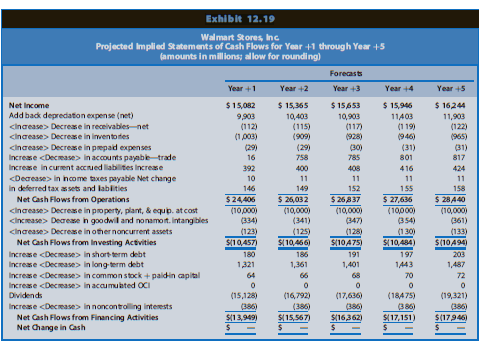In Integrative Case 10.1, we projected financial statements for Walmart Stores for Years +1 through +5. The
Question:
In Integrative Case 10.1, we projected financial statements for Walmart Stores for Years +1 through +5. The data in Chapter 12, Exhibits 12.17 through 12.19 include the actual amounts for 2015 and the projected amounts for Year +1 to Year +5 for the income statements, balance sheets, and statements of cash flows for Walmart (in millions). In this portion of the Walmart Integrative Case, we use the projected financial statements from Chapter 12 and apply the techniques in Chapter 14 to compute Walmart's required rate of return on equity and share value based on the value-to-book valuation model. We also compare our value-to-book ratio estimate to Walmart's market-to-book ratio at the time of the case to determine an investment recommendation. In addition, we compute the value-earnings and price earnings ratios, and we reverse engineer Walmart's share price as of the end of 2015. The market equity beta for Walmart at the end of 2015 was 1.00. Assume that the risk-free interest rate was 3.0% and the market risk premium was 6.0%. Walmart had 3,162 million shares outstanding at the end of 2015, and the share price was $67.50.



REQUIRED
Part I
Computing Walmart's Value-to-Book Ratio Using the Value-to-Book Valuation Approach
a. Use the CAPM to compute the required rate of return on common equity capital for Walmart.
b. Using the projected financial statements in Chapter 12, Exhibits 12.17 through 12.19, derive the projected residual ROCE (return on common shareholders' equity) for Walmart for Years +1 through +5.
c. Assume that the steady-state, long-run growth rate will be 3% in Year +6 and beyond. Project that the Year +5 income statement and balance sheet amounts will grow by 3% in Year +6; then derive the projected residual ROCE for Year +6 for Walmart.
d. Using the required rate of return on common equity from Requirement a as a discount rate, compute the sum of the present value of residual ROCE for Walmart for Years +1 through +5.
e. Using the required rate of return on common equity from Requirement a as a discount rate and the long-run growth rate from Requirement c, compute the continuing value of Walmart as of the start of Year +6 based on Walmart's continuing residual ROCE in Year +6 and beyond. After computing continuing value as of the start of Year +6, discount it to present value at the start of Year +1.
f. Compute Walmart's value-to-book ratio as of the end of 2015 with the following three steps:
(1) Compute the total sum of the present value of all future residual ROCE (from Requirements d and e).
(2) To the total from Requirement f(1), add 1 (representing the book value of equity as of the beginning of the valuation as of the end of 2015).
(3) Adjust the total sum from Requirement f(2) using the midyear discounting adjustment factor.
g. Compute Walmart's market-to-book ratio as of the end of 2015. Compare the value-to book ratio to the market-to-book ratio. What investment decision does the comparison suggest? What does the comparison suggest regarding the pricing of Walmart shares in the market: under priced, overpriced, or fairly priced?
h. Use the value-to-book ratio to project Walmart's share value.
i. If you computed Walmart's common equity share value using the dividends valuation approach in Integrative Case 11.1, and/or the free cash flows to common equity valuation approach in Integrative Case 12.1, and/or the residual income valuation approach in Integrative Case 13.1, compare the value estimate you obtained in those problems with the estimate you obtained in this case. You should obtain the same value estimates under all four approaches. If you have not yet worked those cases, you would benefit from doing so now.
Part II?Analyzing Walmart's Share Price Using the Value-Earnings Ratio, Price-Earnings Ratio, and Reverse Engineering
j. Use the forecast data for Year +1 to project Year +1 earnings per share. To do so, divide Walmart's projected comprehensive income available for common shareholders in Year +1 by the number of common shares outstanding at the end of 2015. Using this Year +1 earnings-per-share forecast and the share value computed in Requirement h, compute Walmart's value-earnings ratio.
k. Using the Year +1 earnings-per-share forecast from Requirement j and using the share price of $67.50 at the end of 2015, compute Walmart's price-earnings ratio. Compare Walmart's value-earnings ratio with its price-earnings ratio. What does the comparison suggest regarding the pricing of Walmart shares in the market: under priced, overpriced, or fairly priced? What investment decision does the comparison suggest? Does this comparison lead to the same conclusions you reached when comparing value-to-book ratios with market-to-book ratios in Requirement g?
l. Reverse engineer Walmart's share price at the end of 2015 to solve for the implied expected rate of return. First, assume that value equals price and that the earnings and 3% long-run growth forecasts in Year +6 and beyond are reliable proxies for the market's expectations for Walmart. Then solve for the implied expected rate of return (the discount rate) the market has impounded in Walmart's share price.
m. Reverse engineer Walmart's share price at the end of 2015 to solve for the implied expected long-run growth. First, assume that value equals price and that the earnings forecasts through Year +5 are reliable proxies for the market's expectations for Walmart. Also assume that the discount rate implied by the CAPM (computed in Requirement a) is a reliable proxy for the market's expected rate of return. Then solve for the implied expected long-run growth rate the market has impounded in Walmart's share price.?
Financial statements are the standardized formats to present the financial information related to a business or an organization for its users. Financial statements contain the historical information as well as current period’s financial... Balance Sheet
Balance sheet is a statement of the financial position of a business that list all the assets, liabilities, and owner’s equity and shareholder’s equity at a particular point of time. A balance sheet is also called as a “statement of financial... Discount Rate
Depending upon the context, the discount rate has two different definitions and usages. First, the discount rate refers to the interest rate charged to the commercial banks and other financial institutions for the loans they take from the Federal...
Step by Step Answer:

Financial Reporting Financial Statement Analysis And Valuation A Strategic Perspective
ISBN: 1711
9th Edition
Authors: James M. Wahlen, Stephen P. Baginski, Mark Bradshaw





